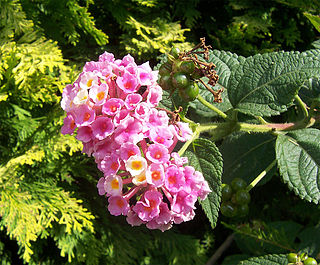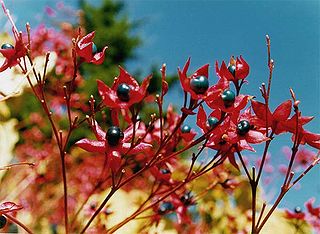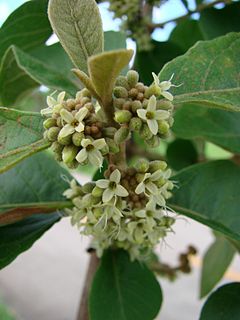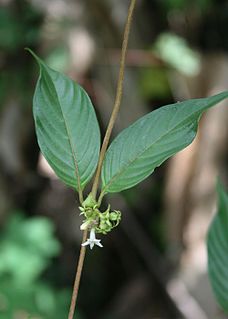
The Lamiaceae or Labiatae are a family of flowering plants commonly known as the mint or deadnettle or sage family. Many of the plants are aromatic in all parts and include widely used culinary herbs like basil, mint, rosemary, sage, savory, marjoram, oregano, hyssop, thyme, lavender, and perilla, as well as other medicinal herbs such as catnip, salvia, bee balm, wild dagga, and oriental motherwort. Some species are shrubs, trees, or, rarely, vines. Many members of the family are widely cultivated, not only for their aromatic qualities, but also their ease of cultivation, since they are readily propagated by stem cuttings. Besides those grown for their edible leaves, some are grown for decorative foliage. Others are grown for seed, such as Salvia hispanica (chia), or for their edible tubers, such as Plectranthus edulis, Plectranthus esculentus, Plectranthus rotundifolius, and Stachys affinis. Many are also grown ornamentally, notably coleus, Plectranthus, and many Salvia species and hybrids.

The Verbenaceae, the verbena family or vervain family, is a family of mainly tropical flowering plants. It contains trees, shrubs, and herbs notable for heads, spikes, or clusters of small flowers, many of which have an aromatic smell.

Clerodendrum is a genus of flowering plants formerly placed in the family Verbenaceae, but now considered to belong to the Lamiaceae (mint) family. Its common names include glorybower, bagflower and bleeding-heart. It is currently classified in the subfamily Ajugoideae, being one of several genera transferred from Verbenaceae to Lamiaceae in the 1990s, based on phylogenetic analysis of morphological and molecular data.
Aegiphila mollis is a species of flowering plant in the family Lamiaceae. It is native to Central and South America. Its common names include contra culebra and totumillo.
Aegiphila cordifolia is a species of flowering plant in the family Lamiaceae. It is endemic to Peru, where it occurs in the Amazon rainforest. It is sometimes found in disturbed habitat.

Aegiphila is a genus of flowering plants in the mint family, Lamiaceae, first described in 1763. It was formerly classified in the Verbenaceae. It is native to Mexico, Central America, South America, the West Indies, and Florida.

Aegiphila ferruginea is a species of flowering plant in the family Lamiaceae. It is endemic to Ecuador. It occurs in the high Andes between 2000 and 4000 meters in elevation, where it grows in cloud forest. There are about 15 wild populations known. It is a shrub or tree that grows easily in disturbed habitat and it can be a common roadside plant in some areas. It is also cultivated on a small scale.
Aegiphila glomerata is a species of flowering plant in the family Lamiaceae. It is endemic to Ecuador, where it has been found at only three locations. It occurs in low-elevation coastal dry forests.
Aegiphila monticola is a species of tree in the family Lamiaceae. It is endemic to Ecuador, where it is known from Cotopaxi and Bolívar Provinces. There are about eight populations.
Aegiphila panamensis is a species of flowering plant in the family Lamiaceae. It is native to the Americas, its distribution extending from Mexico to Colombia.
Aegiphila purpurascens is a species of tree in the family Lamiaceae. It is endemic to Azuay Province in Ecuador, where only three populations are known. It grows in the cloud forests of the Andes at 2000 to 3000 meters in elevation.
Aegiphila schimpffii is a species of tree in the family Lamiaceae. It is endemic to Ecuador, where it is known from five populations. It occurs in coastal forest habitat and foothills up to 1000 meters in elevation.
Aegiphila skutchii is a species of flowering plant in the family Lamiaceae. It is native to Guatemala, Honduras, and Mexico.
Aegiphila sordida is a species of flowering plant in the family Lamiaceae. It is endemic to Peru.

Sabicea is a genus of flowering plants in the family Rubiaceae. They are known commonly as the woodvines. The type species is Sabicea cinerea. There are about 145 species. Most are distributed in tropical Africa and South America.

Ajugoideae is subfamily of the family Lamiaceae. The subfamily name of Teucrioideae is a synonym of Ajugoideae.
Aegiphila monstrosa is a species of flowering plant in the family Lamiaceae. It is found in Belize, Guatemala, Honduras, and Mexico. It is threatened by loss of habitat to agriculture.

Posoquerieae is a tribe of flowering plants in the family Rubiaceae and contains 23 species in 2 genera. Its representatives are found from Mexico to tropical South America.

Aegiphila fasciculata is a species of tree or shrub in the family Lamiaceae. It is native to Brazil. It grows primarily in the seasonally dry tropical biomes.









